oil change HONDA ACCORD COUPE 2001 CF / 6.G Owners Manual
[x] Cancel search | Manufacturer: HONDA, Model Year: 2001, Model line: ACCORD COUPE, Model: HONDA ACCORD COUPE 2001 CF / 6.GPages: 372, PDF Size: 6.1 MB
Page 52 of 372
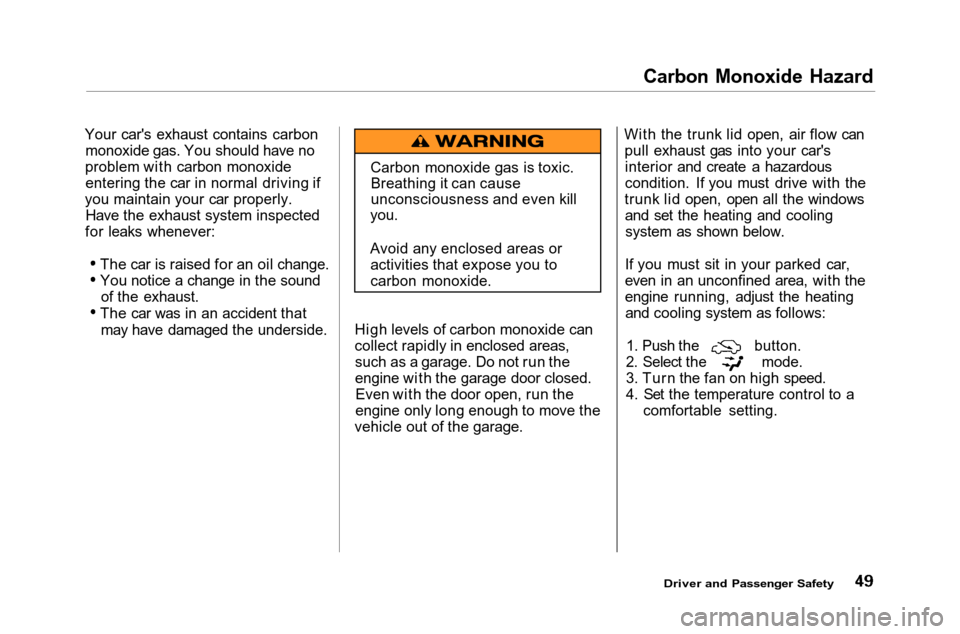
Carbon Monoxide Hazard
Your car's exhaust contains carbon monoxide gas. You should have no
problem with carbon monoxide entering the car in normal driving if
you maintain your car properly. Have the exhaust system inspected
for leaks whenever:
The car is raised for an oil change.
You notice a change in the soundof the exhaust.
The car was in an accident that may have damaged the underside. High levels of carbon monoxide can
collect rapidly in enclosed areas,
such as a garage. Do not run the
engine with the garage door closed.Even with the door open, run the
engine only long enough to move the
vehicle out of the garage. With the trunk lid open, air flow can
pull exhaust gas into your car'sinterior and create a hazardous
condition. If you must drive with the
trunk lid open, open all the windows and set the heating and coolingsystem as shown below.
If you must sit in your parked car,
even in an unconfined area, with the
engine running, adjust the heating and cooling system as follows: 1. Push the button.
2. Select the mode.
3. Turn the fan on high speed.
4. Set the temperature control to a
comfortable setting.
Driver and Passenger Safety
Carbon monoxide gas is toxic.
Breathing it can cause
unconsciousness and even kill
you.
Avoid any enclosed areas or
activities that expose you to
carbon monoxide.
Page 181 of 372
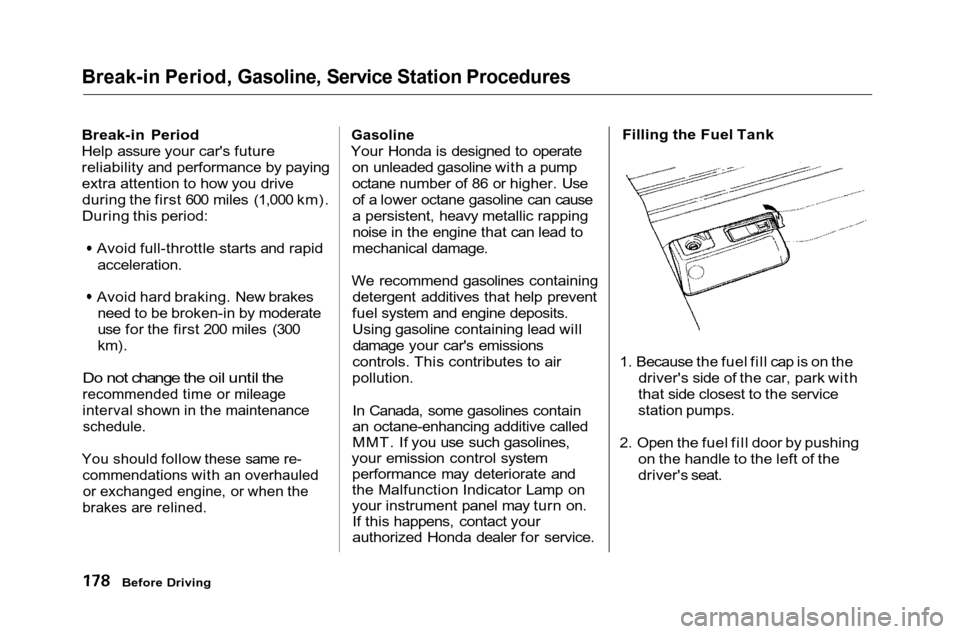
Break-in Period, Gasoline, Service Station Procedures
Break-in Period
Help assure your car's future
reliability and performance by paying
extra attention to how you drive
during the first 600 miles (1,000 km).
During this period: Avoid full-throttle starts and rapid
acceleration.
Avoid hard braking. New brakes
need to be broken-in by moderate
use for the first 200 miles (300
km).
Do not change the oil until the
recommended time or mileage
interval shown in the maintenance
schedule.
You should follow these same re-
commendations with an overhauled
or exchanged engine, or when the
brakes are relined.
Gasoline
Your Honda is designed to operate on unleaded gasoline with a pump
octane number of 86 or higher. Useof a lower octane gasoline can cause
a persistent, heavy metallic rapping
noise in the engine that can lead to
mechanical damage.
We recommend gasolines containing detergent additives that help prevent
fuel system and engine deposits. Using gasoline containing lead willdamage your car's emissions
controls. This contributes to air
pollution.
In Canada, some gasolines contain
an octane-enhancing additive called
MMT. If you use such gasolines,
your emission control system performance may deteriorate and
the Malfunction Indicator Lamp on
your instrument panel may turn on.If this happens, contact your
authorized Honda dealer for service. Filling the Fuel Tank
1. Because the fuel fill cap is on the driver's side of the car, park with
that side closest to the service
station pumps.
2. Open the fuel fill door by pushing on the handle to the left of the
driver's seat.
Before Driving
Page 212 of 372
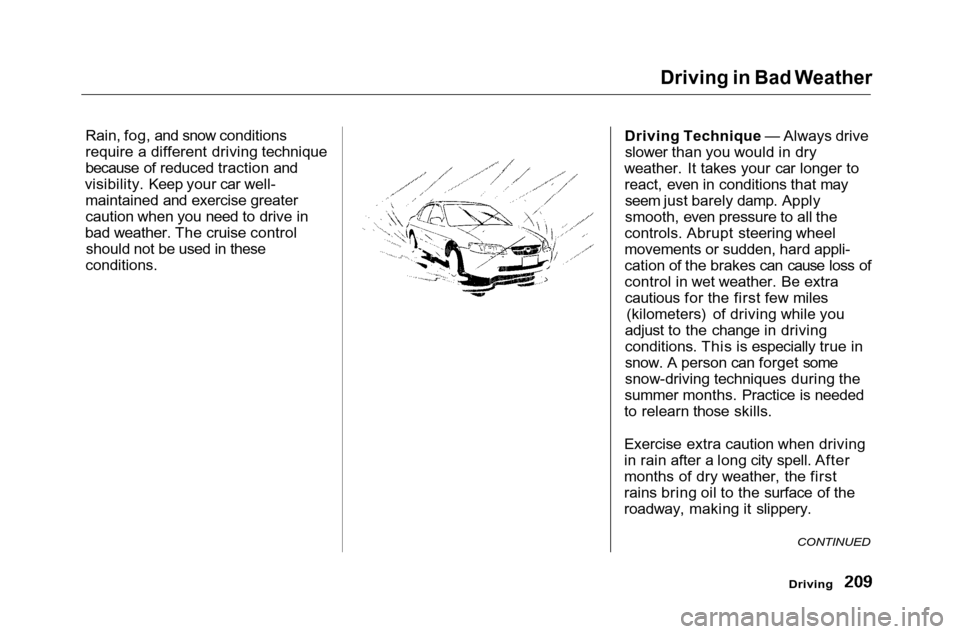
Driving in Bad Weather
Rain, fog, and snow conditions
require a different driving technique
because of reduced traction and
visibility. Keep your car well- maintained and exercise greater
caution when you need to drive in
bad weather. The cruise control should not be used in these
conditions. Driving Technique — Always drive
slower than you would in dry
weather. It takes your car longer to react, even in conditions that mayseem just barely damp. Apply
smooth, even pressure to all the
controls. Abrupt steering wheel
movements or sudden, hard appli-
cation of the brakes can cause loss of
control in wet weather. Be extra cautious for the first few miles (kilometers) of driving while you
adjust to the change in driving
conditions. This is especially true in
snow. A person can forget some
snow-driving techniques during the
summer months. Practice is needed
to relearn those skills.
Exercise extra caution when driving
in rain after a long city spell. After
months of dry weather, the first
rains bring oil to the surface of the
roadway, making it slippery.
Driving
CONTINUED
Page 238 of 372
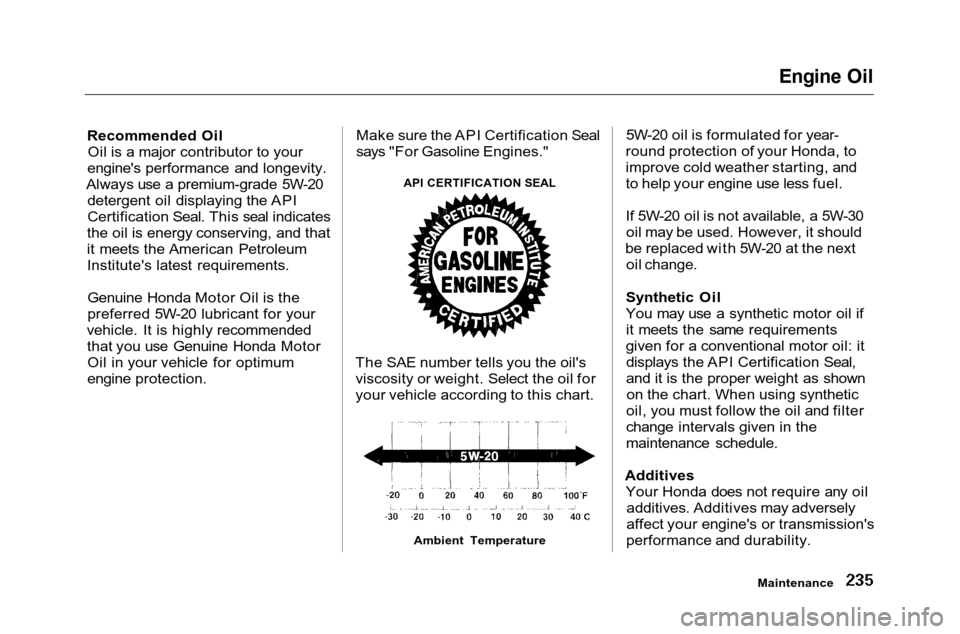
Engine Oil
Recommended Oil Oil is a major contributor to your
engine's performance and longevity.
Always use a premium-grade 5W-20 detergent oil displaying the API
Certification Seal. This seal indicates
the oil is energy conserving, and that
it meets the American Petroleum
Institute's latest requirements.
Genuine Honda Motor Oil is the
preferred 5W-20 lubricant for your
vehicle. It is highly recommended that you use Genuine Honda MotorOil in your vehicle for optimum
engine protection. Make sure the API Certification Seal
says "For Gasoline Engines."
The SAE number tells you the oil's
viscosity or weight. Select the oil for
your vehicle according to this chart. 5W-20 oil is formulated for year-
round protection of your Honda, to
improve cold weather starting, and
to help your engine use less fuel.
If 5W-20 oil is not available, a 5W-30 oil may be used. However, it should
be replaced with 5W-20 at the next oil change.
Synthetic Oil
You may use a synthetic motor oil if it meets the same requirements
given for a conventional motor oil: it displays the API Certification Seal,
and it is the proper weight as shownon the chart. When using synthetic
oil, you must follow the oil and filter
change intervals given in the
maintenance schedule.
Additives Your Honda does not require any oiladditives. Additives may adversely
affect your engine's or transmission's
performance and durability.
Maintenance
API CERTIFICATION SEAL
Ambient Temperature
Page 239 of 372
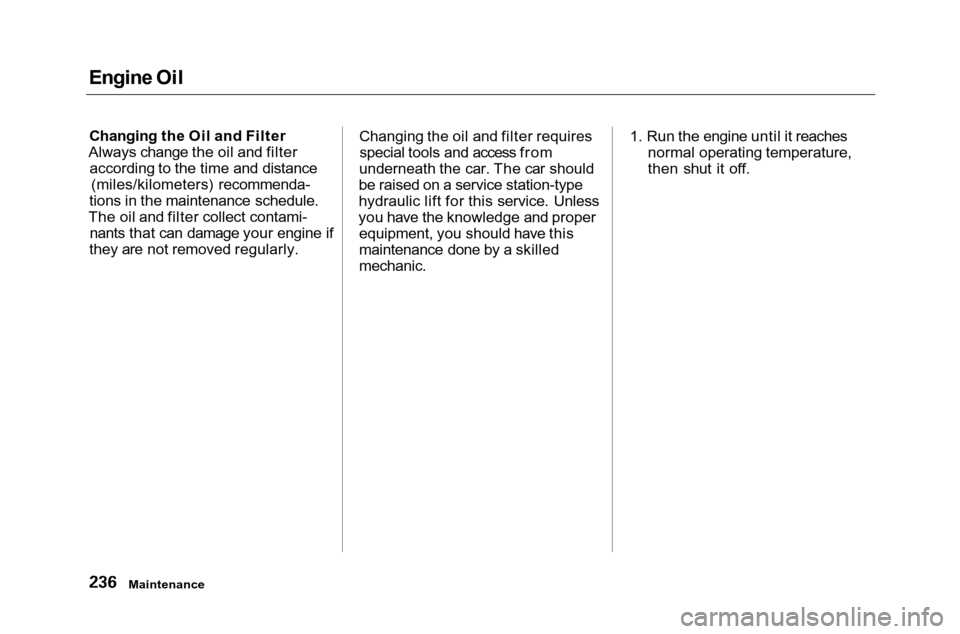
Engine Oil
Changing the Oil and Filter
Always change the oil and filter according to the time and distance (miles/kilometers) recommenda-
tions in the maintenance schedule.
The oil and filter collect contami- nants that can damage your engine if
they are not removed regularly. Changing the oil and filter requires
special tools and access from
underneath the car. The car should
be raised on a service station-type
hydraulic lift for this service. Unless
you have the knowledge and proper equipment, you should have this
maintenance done by a skilled
mechanic. 1. Run the engine until it reaches
normal operating temperature,
then shut it off.
Maintenance
Page 241 of 372
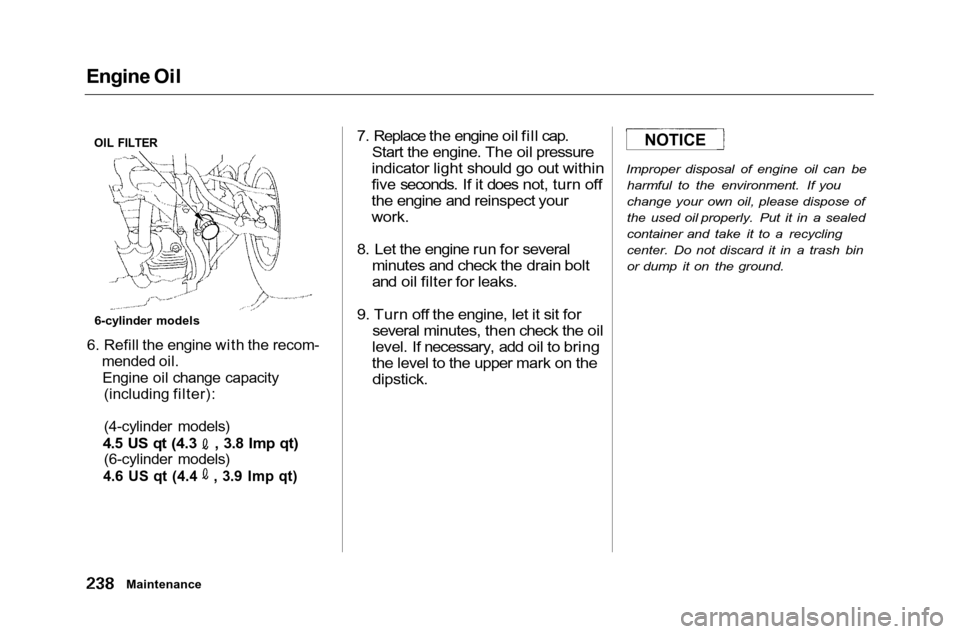
Engine Oil
6. Refill the engine with the recom- mended oil.
Engine oil change capacity (including filter):
(4-cylinder models)
4.5 US qt (4.3 , 3.8 Imp qt)
(6-cylinder models)
4.6 US qt (4.4 , 3.9 Imp qt)
7. Replace the engine oil fill cap.
Start the engine. The oil pressure
indicator light should go out within
five seconds. If it does not, turn off
the engine and reinspect your
work.
8. Let the engine run for several minutes and check the drain bolt
and oil filter for leaks.
9. Turn off the engine, let it sit for several minutes, then check the oil
level. If necessary, add oil to bring
the level to the upper mark on the
dipstick.
Improper disposal of engine oil can be
harmful to the environment. If you
change your own oil, please dispose of
the used oil properly. Put it in a sealed
container and take it to a recycling
center. Do not discard it in a trash bin
or dump it on the ground.
Maintenance
NOTICE
OIL FILTER
6-cylinder models
Page 279 of 372
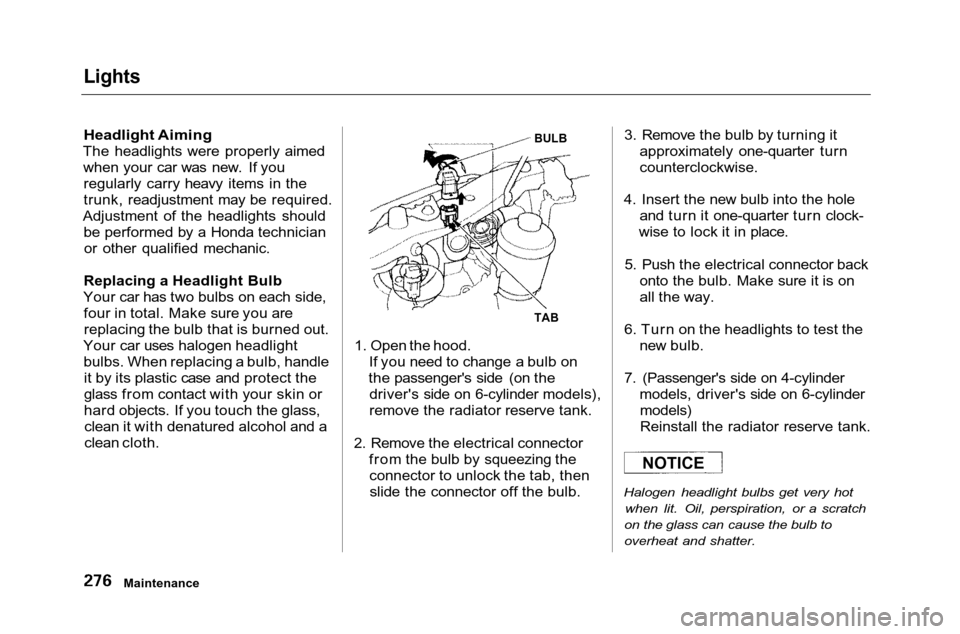
Lights
Headlight Aiming
The headlights were properly aimed when your car was new. If youregularly carry heavy items in the
trunk, readjustment may be required.
Adjustment of the headlights should be performed by a Honda technicianor other qualified mechanic.
Replacing a Headlight Bulb
Your car has two bulbs on each side, four in total. Make sure you arereplacing the bulb that is burned out.
Your car uses halogen headlight bulbs. When replacing a bulb, handleit by its plastic case and protect the
glass from contact with your skin or
hard objects. If you touch the glass,clean it with denatured alcohol and a
clean cloth.
BULB
1. Open the hood. If you need to change a bulb on
the passenger's side (on the driver's side on 6-cylinder models),
remove the radiator reserve tank.
2. Remove the electrical connector from the bulb by squeezing theconnector to unlock the tab, thenslide the connector off the bulb. 3. Remove the bulb by turning it
approximately one-quarter turn
counterclockwise.
4. Insert the new bulb into the hole and turn it one-quarter turn clock-
wise to lock it in place.
5. Push the electrical connector back onto the bulb. Make sure it is on
all the way.
6. Turn on the headlights to test the new bulb.
7. (Passenger's side on 4-cylinder models, driver's side on 6-cylindermodels)
Reinstall the radiator reserve tank.
Halogen headlight bulbs get very hot when lit. Oil, perspiration, or a scratch
on the glass can cause the bulb to
overheat and shatter.
Maintenance
NOTICE
TAB
Page 288 of 372
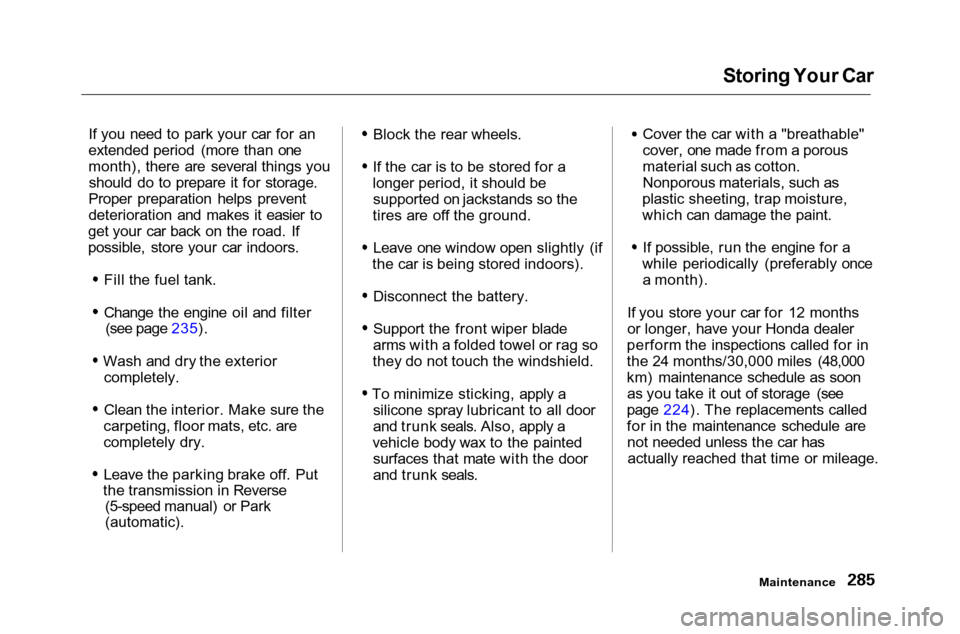
Storing Your Car
If you need to park your car for an
extended period (more than one
month), there are several things you should do to prepare it for storage.
Proper preparation helps prevent
deterioration and makes it easier to
get your car back on the road. If
possible, store your car indoors.
Fill the fuel tank.
Change the engine oil and filter(see page 235).
Wash and dry the exterior completely.
Clean the interior. Make sure the
carpeting, floor mats, etc. are
completely dry.
Leave the parking brake off. Put
the transmission in Reverse (5-speed manual) or Park
(automatic).
Block the rear wheels.
If the car is to be stored for a
longer period, it should be supported on jackstands so the
tires are off the ground.
Leave one window open slightly (if
the car is being stored indoors).
Disconnect the battery.
Support the front wiper blade
arms with a folded towel or rag so
they do not touch the windshield.
To minimize sticking, apply a silicone spray lubricant to all door
and trunk seals. Also, apply a
vehicle body wax to the painted surfaces that mate with the door
and trunk seals. Cover the car with a "breathable"
cover, one made from a porous
material such as cotton.
Nonporous materials, such as
plastic sheeting, trap moisture,
which can damage the paint.
If possible, run the engine for a
while periodically (preferably once a month).
If you store your car for 12 months
or longer, have your Honda dealer
perform the inspections called for in
the 24 months/30,000 miles (48,000
km) maintenance schedule as soon as you take it out of storage (see
page 224). The replacements called
for in the maintenance schedule are not needed unless the car hasactually reached that time or mileage.
Maintenance
Page 351 of 372
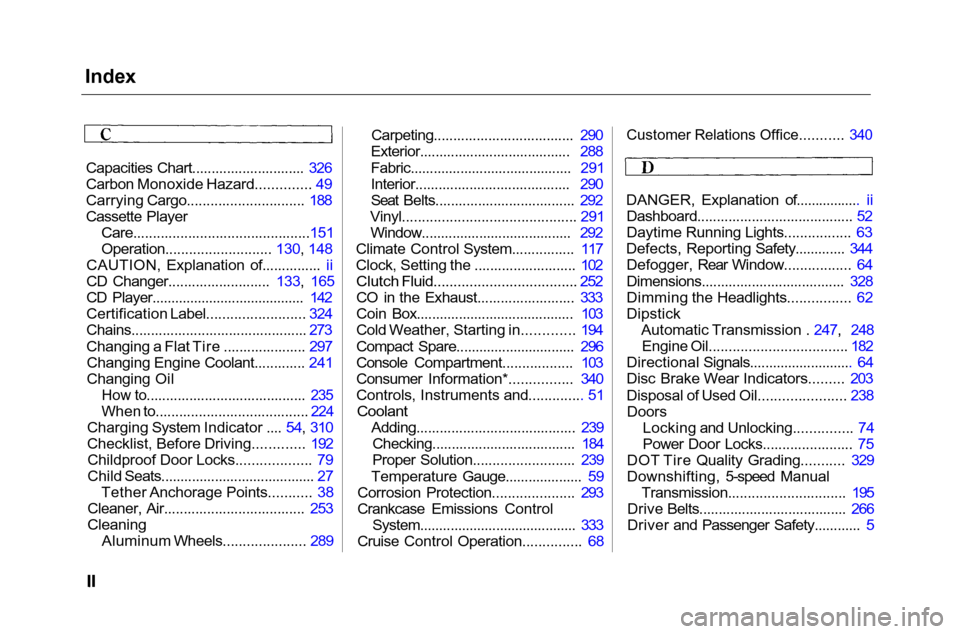
Index
Capacities Chart............................. 326
Carbon Monoxide Hazard.............. 49
Carrying Cargo.............................. 188
Cassette Player
Care.............................................151
Operation........................... 130, 148
CAUTION, Explanation of............... ii
CD Changer.......................... 133, 165
CD Player........................................ 142
Certification Label......................... 324
Chains............................................. 273
Changing a Flat Tire ..................... 297 Changing Engine Coolant.............
241
Changing Oil
How to......................................... 235
When to....................................... 224
Charging System Indicator .... 54, 310
Checklist, Before Driving............. 192 Childproof Door Locks................... 79
Child Seats........................................ 27 Tether Anchorage Points........... 38
Cleaner, Air.................................... 253
Cleaning
Aluminum Wheels..................... 289 Carpeting.................................... 290
Exterior....................................... 288
Fabric.......................................... 291
Interior........................................ 290
Seat Belts.................................... 292
Vinyl............................................ 291 Window....................................... 292
Climate Control System................ 117
Clock, Setting the .......................... 102
Clutch Fluid.................................... 252
CO in the Exhaust......................... 333
Coin Box......................................... 103
Cold Weather, Starting in............. 194
Compact Spare............................... 296
Console Compartment.................. 103
Consumer Information*................ 340
Controls, Instruments and..............
51
Coolant
Adding......................................... 239Checking..................................... 184
Proper Solution.......................... 239
Temperature Gauge.................... 59
Corrosion Protection..................... 293
Crankcase Emissions Control System......................................... 333
Cruise Control Operation............... 68
Customer Relations Office........... 340
DANGER, Explanation of................. ii Dashboard........................................ 52
Daytime Running Lights................. 63
Defects, Reporting Safety............. 344 Defogger, Rear Window................. 64
Dimensions..................................... 328
Dimming the Headlights................ 62
Dipstick Automatic Transmission . 247, 248
Engine Oil................................... 182
Directional Signals........................... 64
Disc Brake Wear Indicators......... 203
Disposal of Used Oil...................... 238 Doors Locking and Unlocking............... 74
Power Door Locks....................... 75
DOT Tire Quality Grading........... 329
Downshifting, 5-speed Manual Transmission.............................. 195
Drive Belts...................................... 266
Driver and Passenger Safety............ 5
Page 354 of 372
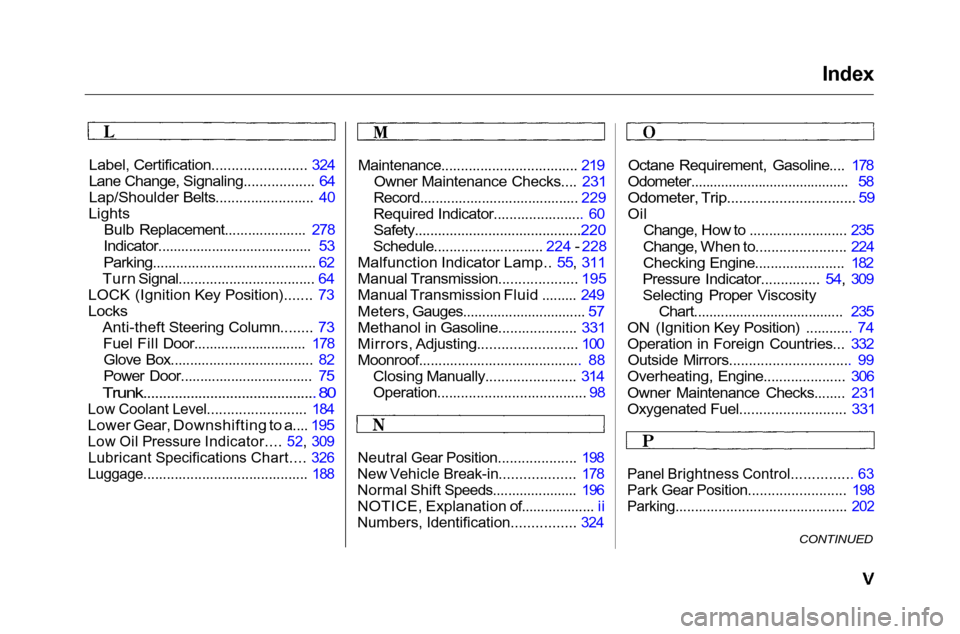
Index
Label, Certification........................ 324
Lane Change, Signaling.................. 64
Lap/Shoulder Belts......................... 40
Lights Bulb Replacement..................... 278
Indicator........................................ 53
Parking.......................................... 62
Turn Signal................................... 64
LOCK (Ignition Key Position)....... 73
Locks
Anti-theft Steering Column........ 73Fuel Fill Door............................. 178Glove Box..................................... 82
Power Door.................................. 75
Trunk............................................
80
Low Coolant Level......................... 184
Lower Gear, Downshifting to a.... 195
Low Oil Pressure Indicator.... 52, 309
Lubricant Specifications Chart.... 326
Luggage.......................................... 188
Maintenance................................... 219
Owner Maintenance Checks.... 231
Record......................................... 229
Required Indicator....................... 60
Safety...........................................220
Schedule............................
224 -
228
Malfunction Indicator Lamp.. 55, 311
Manual Transmission.................... 195
Manual Transmission Fluid ......... 249
Meters, Gauges................................ 57
Methanol in Gasoline.................... 331
Mirrors, Adjusting......................... 100
Moonroof.......................................... 88
Closing Manually....................... 314
Operation...................................... 98
Neutral Gear Position.................... 198
New Vehicle Break-in................... 178
Normal Shift Speeds...................... 196
NOTICE, Explanation of................... ii
Numbers, Identification................ 324
Octane Requirement, Gasoline.... 178
Odometer.......................................... 58
Odometer, Trip................................ 59
Oil Change, How to ......................... 235
Change, When to....................... 224
Checking Engine....................... 182
Pressure Indicator............... 54, 309
Selecting Proper Viscosity Chart....................................... 235
ON (Ignition Key Position) ............ 74
Operation in Foreign Countries... 332 Outside Mirrors............................... 99
Overheating, Engine..................... 306
Owner Maintenance Checks........ 231
Oxygenated Fuel........................... 331
Panel Brightness Control............... 63
Park Gear Position......................... 198
Parking............................................ 202
CONTINUED